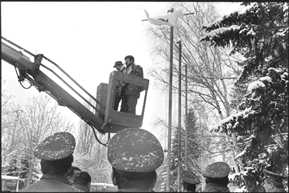

|
In a ritual mapped out during the previous transitions of the other suburbs to Bosnian rule, a contingent of Bosnian Federation police, supposed to be a fair representation of the three ethnic groups, had walked in to take over the police station, remove any leftover symbols of Serbian Republic control, and plant a flag. Meanwhile Sarajevo's inhabitants, many of whom had had to flee the suburbs at the beginning of the war, waited patiently behind police lines to be finally permitted to cross the old front lines. Anxious to visit their old neighborhood, most for the first time in four years, they were also curious to see the feared and mysterious world from which they had been sniped at and shelled during the war. Clustered in small groups, wearing the best clothes that they had managed to salvage, friends and families walked like a human river and started to spread among the gray buildings. Looking for their homes, encountering old friends in frantic reunions punctuated by embrace, torn between joy and sorrow, by and large they expressed little exuberance. Although some families were reunited after long separation, for most the only traces of the past were images. Images were everywhere, littering the floor inside homes, in the street, family images to be caressed, political images to be torn, private and public memories of times now gone. The siege was over, but we were all uncertain as to whether peace had actually come. |
![]()